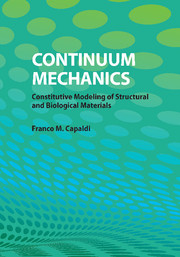1 - Mathematics
Published online by Cambridge University Press: 05 August 2012
Summary
As scientists and engineers, we make sense of the world around us through observation and experimentation. Using mathematics, we attempt to describe our observations andmake useful predictions based on these observations. For example, a simple experimental observation that the distance traversed by an object traveling at a constant velocity is linearly related to both the velocity and the time can be formalized using the relation, d = vt, where d is the distance vector, v is the velocity vector, and t is the time. The distance, velocity, and time are physical quantities that can be measured or controlled. Physical quantities such as distance, velocity, and time are represented mathematically as tensors. A scalar, for example, is a zeroth-order tensor. Only amagnitude is required to specify the value of a zeroth-order tensor. In our previous example, time is such a quantity. If you are told that the duration of an event was 3 seconds, you need no other information to fully characterize this physical quantity. Velocity, on the other hand, requires both a magnitude and a direction to specify its meaning. The velocity would be represented using a first-order tensor, also known as a vector. The internal stress in a material is a second-order tensor, which requires a magnitude and two directions to specify its value. You may recognize that the two required directions are the normal of the surface on which the stress acts and the direction of the traction vector on this surface.
- Type
- Chapter
- Information
- Continuum MechanicsConstitutive Modeling of Structural and Biological Materials, pp. 1 - 34Publisher: Cambridge University PressPrint publication year: 2012



